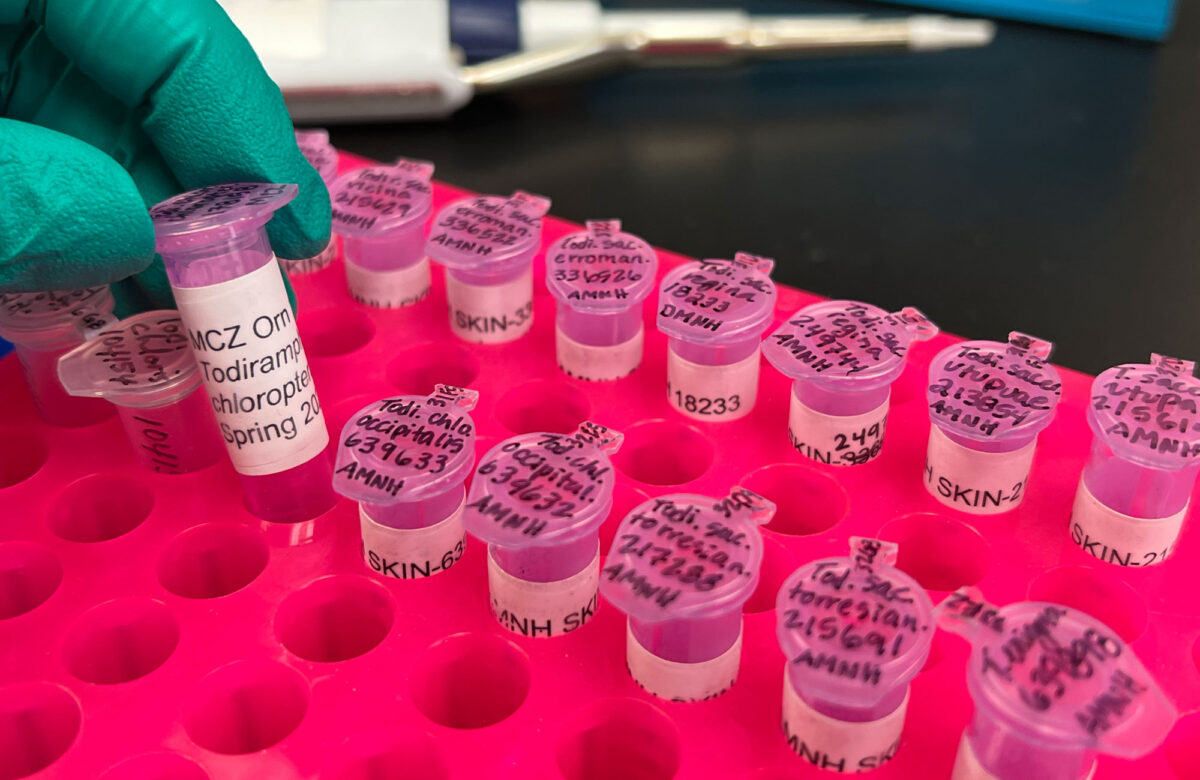Page snapshot: An overview of species radiations on islands, the difference between adaptive and geographic radiations, and how studying Australo-Pacific kingfishers helps scientists to understand geographic radiations.
Topics covered on this page: Island and species radiations; The importance of the Australo-Pacific region to understanding species and speciation; Adaptive radiations on islands; Geographic radiations on islands; The geographic radiation of Australo-Pacific kingfishers; Resources.
Credits: Funded by the National Science Foundation. Any opinions, findings, and conclusions or recommendations expressed in this material are those of the author(s) and do not necessarily reflect the views of the National Science Foundation.
Updates: Page last updated March 12, 2024.
Image above: Tissue samples from Australo-Pacific kingfishers (Todiramphus). Photo courtesy of the PIs of this project (all rights reserved).
Islands and species radiations
Islands have long been used to study speciation in wild populations of animals and plants. Speciation is the process by which new species evolve. Species radiations occur when multiple new species evolve in a single group in a relatively short period of time. In evolutionary terms, a short time may be one or a few million years—so, not a short time by the standards of human history!
Islands are great places to study species radiations because each island is a piece of land surrounded by water. Thus, species that live on different islands are physically separated from one another. Furthermore, many islands have well-studied geologic records. Knowing the geologic record of an island helps scientists understand species radiations because, for example, the age of an island may indicate the likely maximum (oldest possible) age of a species that is unique to that island.
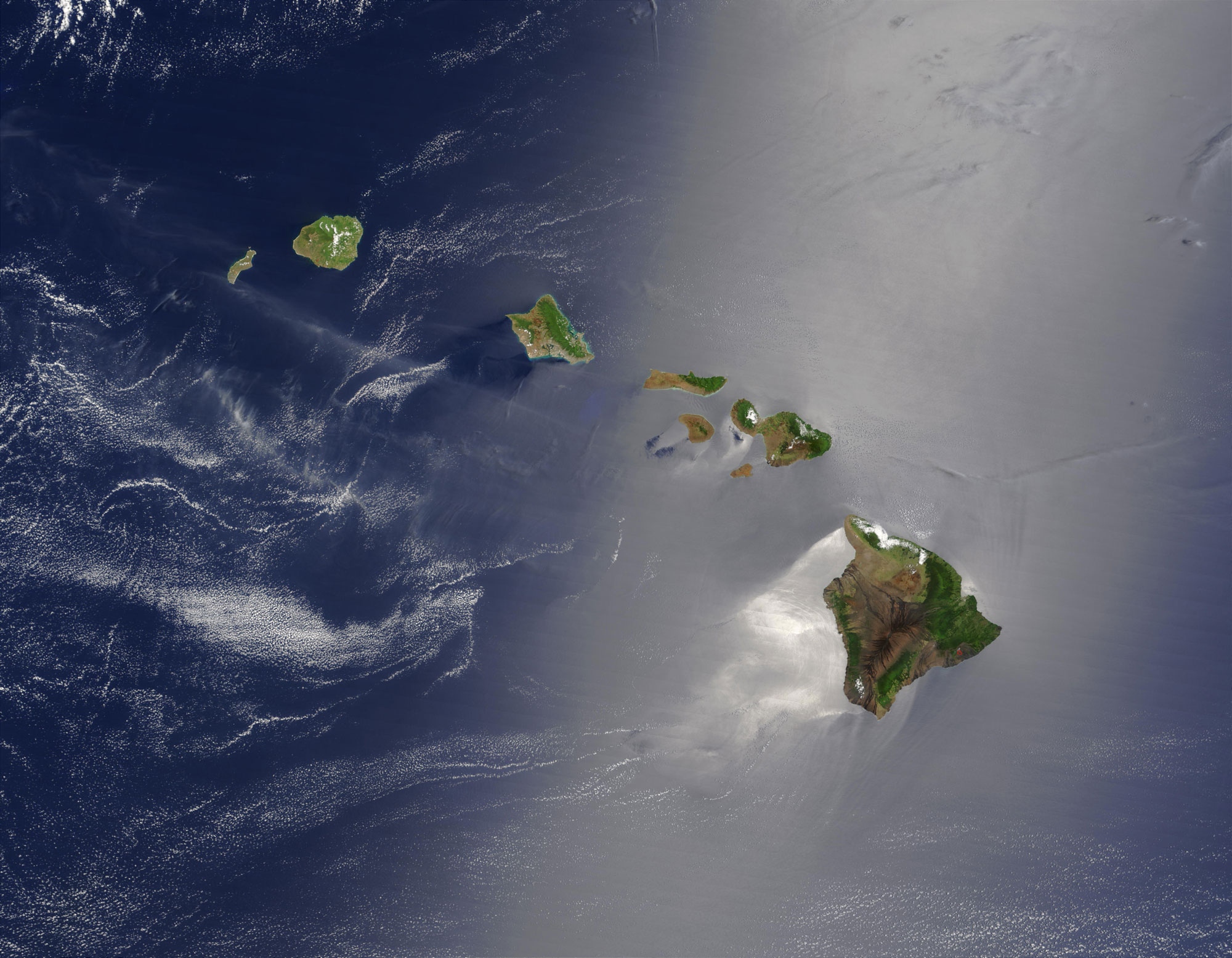
Satellite photo of the Hawaiian Islands surrounded by the waters of the Pacific Ocean. The Hawaiian Islands are one of the groups of islands on which species radiations have been studied. Photo by Jacques Descloitres, MODIS Land Rapid Response Team at NASA GSFC (NASA Earth Observatory, used following NASA's image use policy).
The importance of the Australo-Pacific region to understanding species and speciation
The Australo-Pacific region is the cradle of speciation theory, and studies of Australo-Pacific island animals are still helping scientists to understand how biodiversity is created and structured. The study of animals on these islands has influenced ecological and evolutionary theory, contributing to important ideas and observations like the following:
The theory of island biogeography
The theory of island biogeography was first proposed by two ecologists, Robert MacArthur and E.O. Wilson, and explains why some islands have more species than others. Under this theory, the number of species on an island is determined by the island's size and its distance from large landmasses. This is because an island's size (land area) determines the number of species that it can support, and an island's distance from large landmasses influences how many species can migrate to and colonize the island.
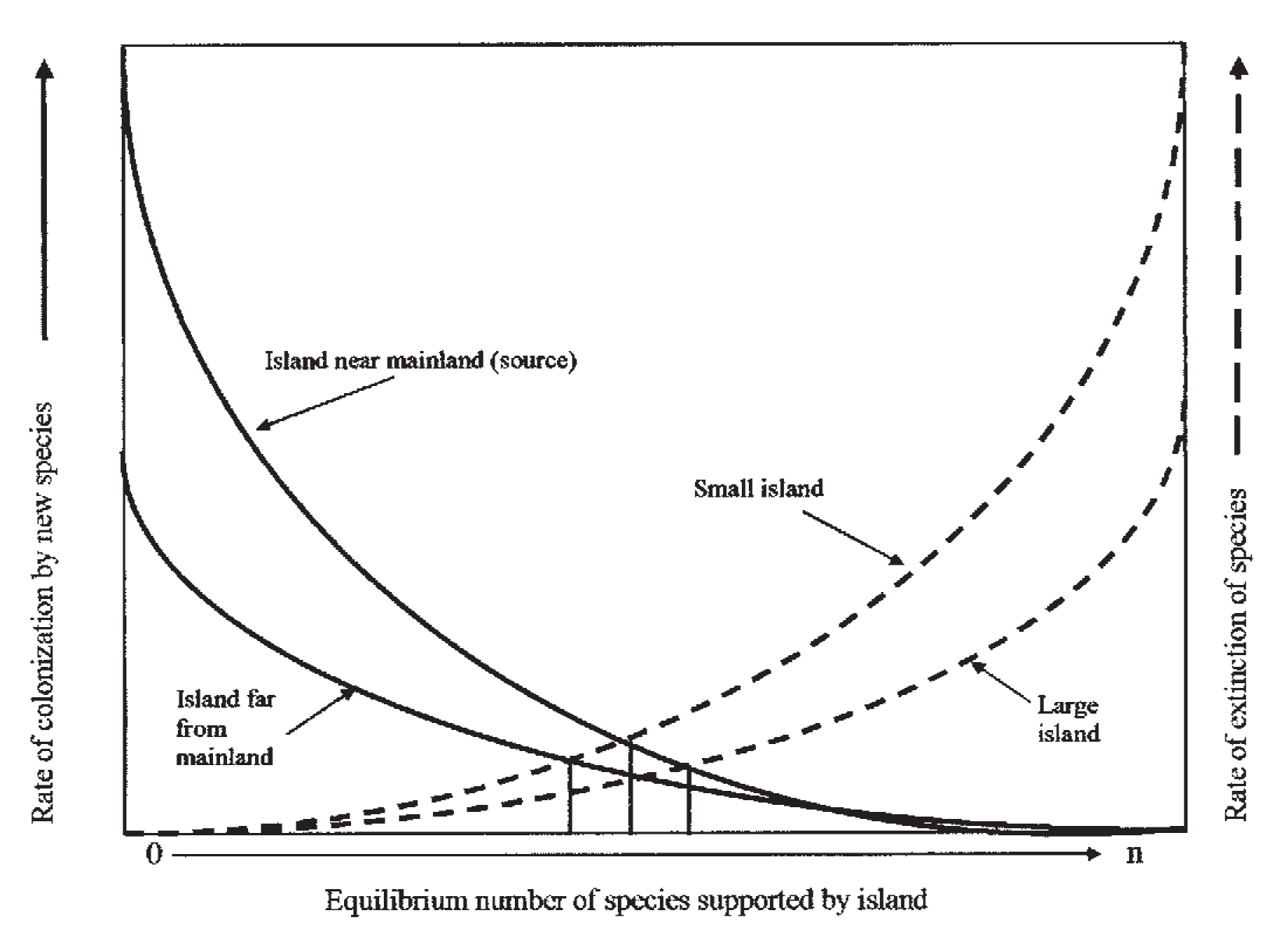
Original caption: "Graphic representation of island biogeography theory. Large islands located near a potential source of colonists should support a greater equilibrium number of species due to high immigration rates and low extinction rates. Small, isolated islands are predicted to have the least number of species due to lower colonization rates and greater extinction rates (after MacArthur and Wilson 1967)." From: USDA Forest Service Gen. Tech. Rep. RMRS-GTR-135-vol. 1, chapter 4 (2004).
The great speciator paradox
The great speciator paradox is the observation that some types of birds that live on groups of islands have many distinct species and subspecies, while other types of birds that live on the same groups of islands do not. The great speciator paradox was originally discussed by Jared Diamond, Michael Gilpin, and Ernst Mayr, who observed that white eyes (birds in the family Zosteropidae) in the Solomon Islands had diversified into different species on different islands, whereas other types of birds on the islands had not.

Santa Cruz white-eye (Zosterops santaecrucis), Santa Cruz Islands, Solomon Islands. Photo by Bird Explorers (iNaturalist, Creative Commons Attribution-NonCommercial 4.0 International license).
Taxon cycles
Taxon cycles were first proposed by E.O. Wilson to explain the persistence or extinction of species over time. Wilson specifically based the taxon cycle on his studies of ants in Melanesia. Melanesia is a region of islands near Australia that stretches from the island of New Guinea in the west to Fiji in the east.
A taxon cycle is a cycle in which a species range expands and then contracts. During a taxon cycle, a species expands its range so that it covers a relatively large area. Then, the species begins to diversify into multiple separate species, each with a relatively small geographic range. At least one of these species will have to expand its range again. If not, the group of species may go entirely extinct.

An ant (Aphaenogaster dromedaria) native to New Guinea. Photo by Mattia Menchetti (iNaturalist, Creative Commons Attribution 4.0 International license).
Adaptive radiations on islands
The best known type of species radiation is probably the adaptive radiation. In adaptive radiations, new species have key innovations or obvious adaptive changes. Famous examples of adaptive radiations of species have been documented in the Galapagos Islands and the Hawaiian Islands.
On the Galapagos Islands, one of the most well known examples of an adapative species radiation is the radiation of Darwin's finches. The finches probably evolved from a type of grassquit, a South America bird. Once in the Galapagos, the finches colonized different islands and also evolved into multiple species with different types of beaks that allowed them to eat different types of foods.
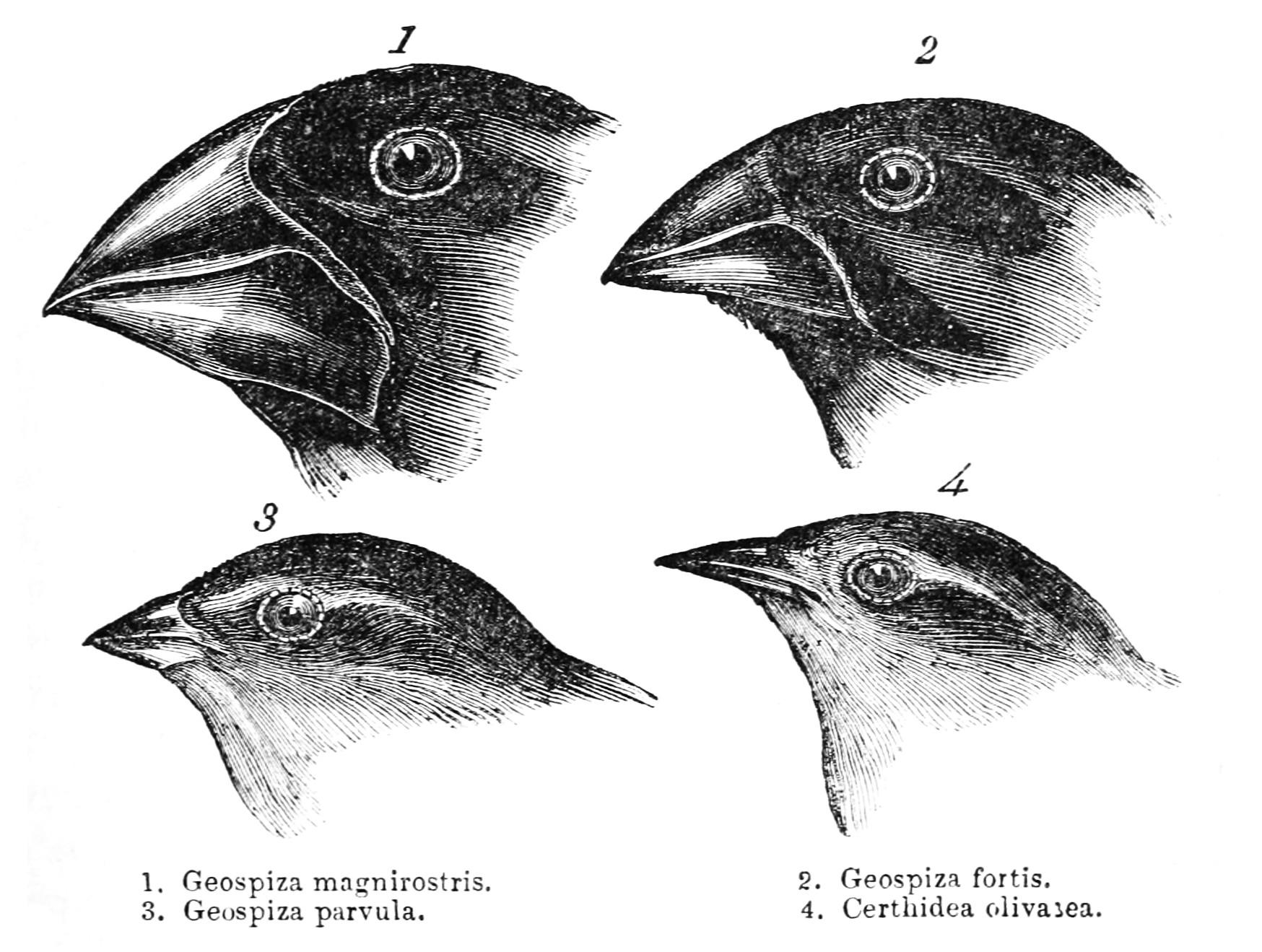
Drawings of some of Darwin's finches showing their beaks. 1. Large ground finch (Geospiz magirostris), a seed-eater. 2. Medium ground finch (Geospiza fortis), a generalist. 3. Small tree-finch (Camarhynchus parvulus, formerly Geospiz parvula), an insect-eater. 4. Green warbler-finch (Certhidea olivacea), an insect-eater. From Darwin (1845) Journal of researches into the natural history and geology of the countries visited during the voyage of H.M.S. Beagle round the world, under the Command of Capt. Fitz Roy, R.N. 2nd ed. (Wikimedia Commons, public domain).
On the Hawaiian Islands, a well known radiation has occurred in the silversword alliance, a group of plants in the aster or sunflower family. Silverswords evolved from North America tarweeds that colonized the Hawaiian Islands; the silverswords include multiple species with a variety of growth forms that are adapted to the different type of habitats on the Hawaiian Islands. The ancestor to all the silverswords is thought to have reached the Hawaiian Islands about 5 million years ago.
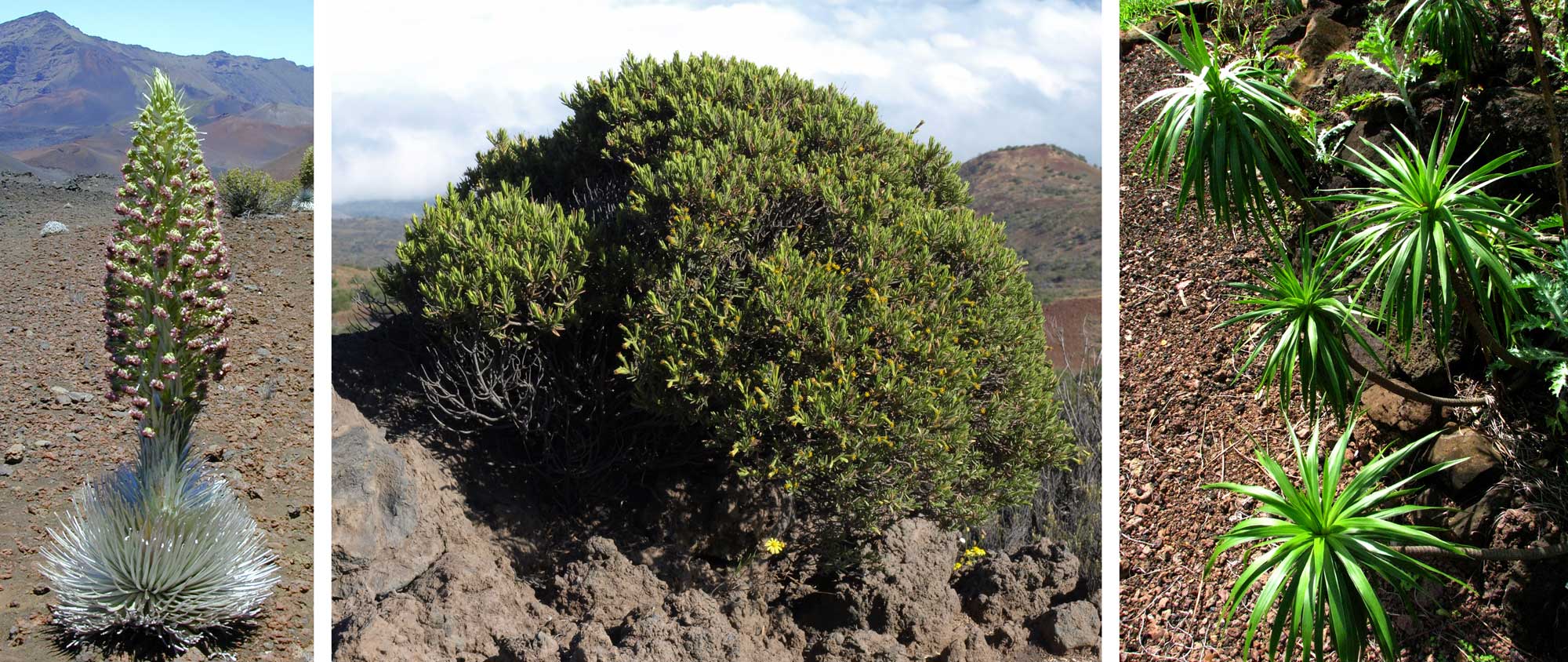
Plants that are part of the Hawaiian silversword alliance showing different growth forms. Left: Haleakala silversword (Argyroxiphium sandwicense subspecies macrocephalum), Maui. Center: Lava dubautia (Dubautia cilioata subspecies glutinosa), Mauna Kea, Hawaii Island. Right: Dwarf iliau (Wilkesia hobdyi), Kaua'i. Left photo by Forest & Kim Starr (Wikimedia Commons, Creative Commons Attribution 3.0 Unported license). Center photo by Jim Morefield (flickr, Creative Commons Attribution-ShareAlike 2.0 Generic license). Right photo by David Eickhoff (flickr, Creative Commons Attribution 2.0 Generic license). All images cropped and resized.
Geographic radiations on islands
In contrast to an adaptive radiation, a geographic radiation is a rapid diversification of species across islands in which the species do not have clear adaptive changes. The radiation of white eyes that inspired the great speciator paradox is an example of a geographic radiation. Notably, much of the species diversity of white eyes is concentrated in two island archipelagos: the Indonesian Archipelago (24 species) and the Melanesian Archipelago (32 species).

A lemon-bellied white-eye (Zosterops chloris), Sulawesi, Indonesia. Photo by Christoph Moning (iNaturalist, Creative Commons Attribution 4.0 International license).
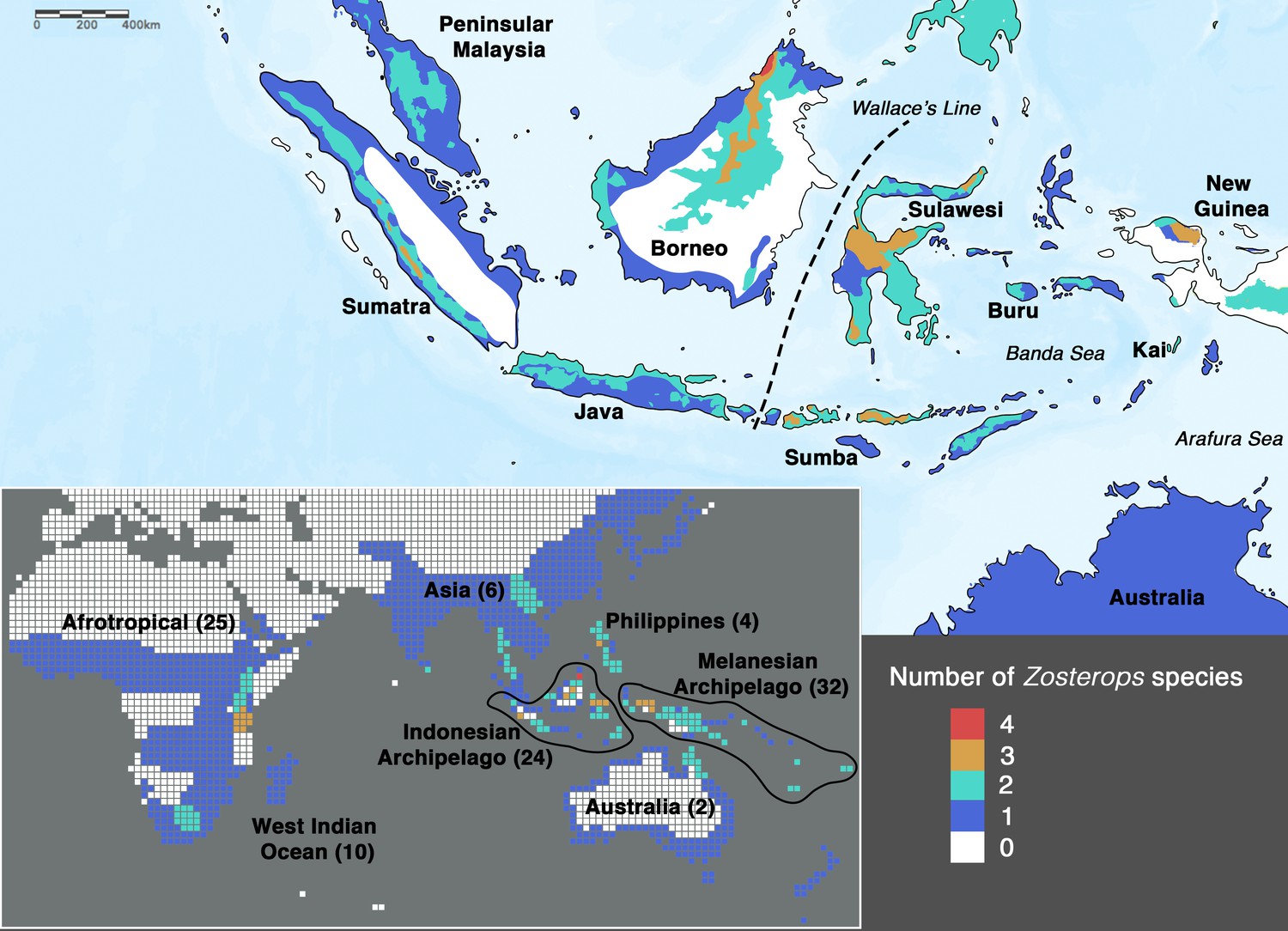
A map of the number of species of white eyes (Zosterops) across its entire distribution (lower left) and in the Indonesia Archipelago (upper map), where white eyes are very diverse. From: Gwee et al. (2020) eLife (Creative Commons Attribution 4.0 International license).
The geographic radiation of Australo-Pacific kingfishers
Australo-Pacific kingfishers (Todiramphus) are widespread and include many species and subspecies that originated during a geographic radiation. Australo-Pacific kingfishers are distributed from eastern Africa to French Polynesia in the Pacific Ocean, and scientists think that they diversified more rapidly than other groups of birds that have undergone species radiations. Australo-Pacific kingfishers are ideal for studying geographic radiations because they have a wide distribution on both continents and islands, they have diversified rapidly, and they are divided into many species. The species and subspecies of Australo-Pacific kingfishers also vary in their ecologies, feather patterns and colors, and distributions.
In order to study Australo-Pacific kingfishers, scientists collect DNA and build datasets of physical and ecological traits to understand the biological processes that underlie the species radiation in these birds. They can then compare their results to the results of investigations of species radiations in other kinds of birds and even other types of organisms. By studying and comparing species radiations in different organisms that live in different areas of the world, scientists can better understand rapid radiations in nature generally and how genes and physical traits interact during the origination of new species.
In investigating Australo-Pacific kingfishers, scientists are especially interested in determining:
- How changes in the DNA of Australo-Pacific kingfishers have helped to drive their speciation.
- How the physical and ecological traits of Australo-Pacific kingfishers have influenced the process of speciation.
- How the genes and physical traits of Australo-Pacific kingfishers are related to the environments that they inhabit.

A sacred kingfisher (Todiramphus sanctus), Papua New Guinea. Photo by Eric Carpenter (iNaturalist, Creative Commons Attribution-NonCommercial 4.0 International license).
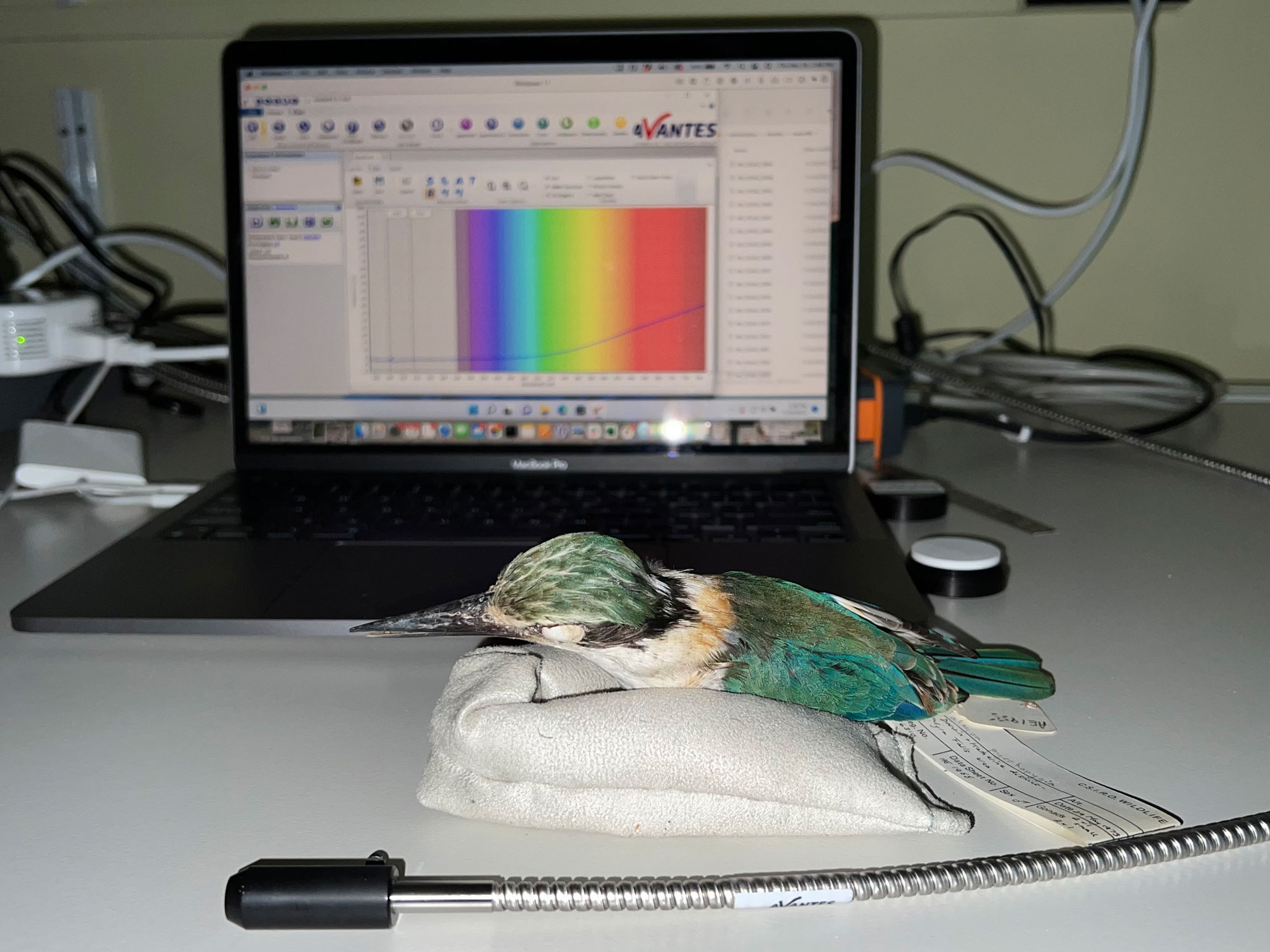
A preserved specimen of a red-backed kingfisher (Todiramphus pyrrhopygius) displayed with equipment for analyzing plumage color. Photo by the project PIs (all rights reserved).
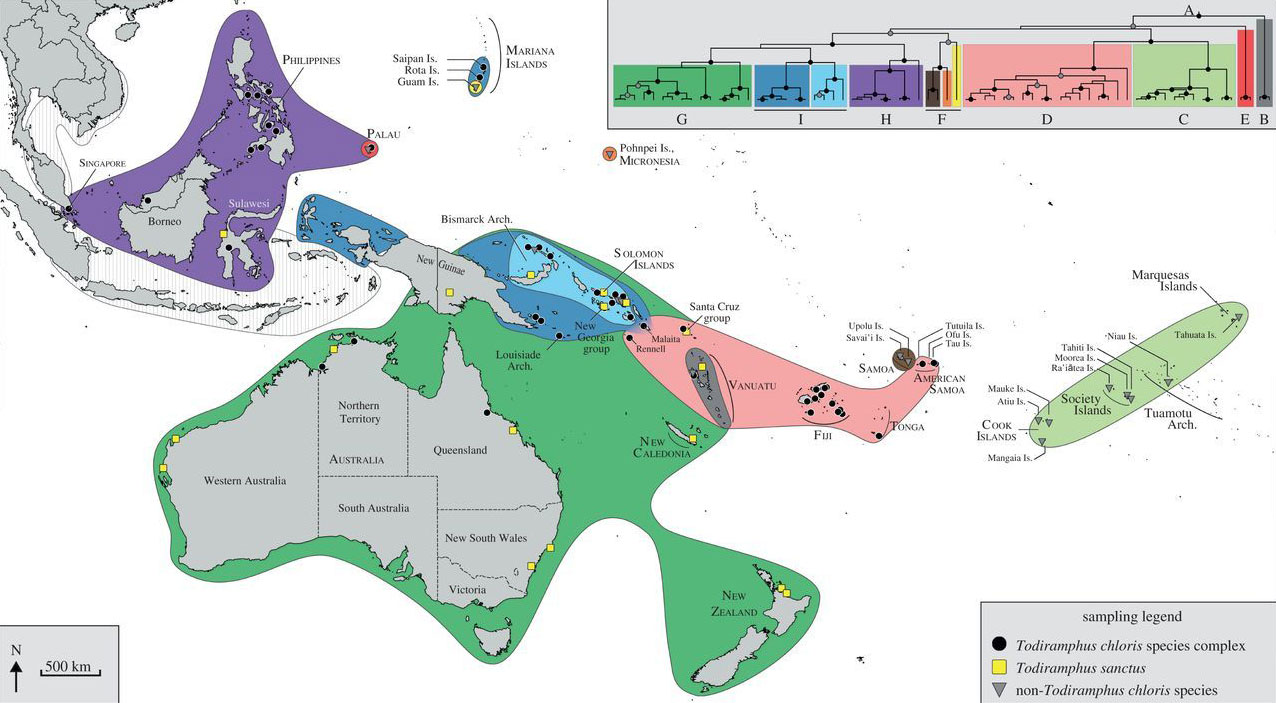
A figure from a study of the collared kingfisher (Todiramphus chloris) species complex. The tree of relationships in the upper right shows the relationships among different birds whose DNA was sampled and analyzed. The map is shaded to show the distributions of different groups of birds that are color-coded on the tree. Source: Figure 1 from Andersen et al. (2015) Royal Society Open Science (Creative Commons Attribution 4.0 International license, image cropped).
Resources
Web resources
Evolutionary radiations (J.R. Hendricks and B.L. Lieberman, Digital Encyclopedia of Ancient Life): https://www.digitalatlasofancientlife.org/learn/evolution/macroevolution/evolutionary-radiations/
'Great speciators' explained: it's intrinsic (Phys.org): https://phys.org/news/2009-01-great-speciators-intrinsic.html
Island biogeography (P.R. Ehrlich, D.S. Dobkin, and D. Wheye, Stanford University): https://web.stanford.edu/group/stanfordbirds/text/essays/Island_Biogeography.html
Selected scientist bios
2005. Ernst Mayr, 100, premier evolutionary biologist. The New York Times, 4 February 2005. https://www.nytimes.com/2005/02/04/science/ernst-mayr-100-premier-evolutionary-biologist.html
Bock, W.J. 2014. Ernst W. Mayr (1904-2005). National Academy of Sciences Biographical Memoir. PDF: https://www.nasonline.org/publications/biographical-memoirs/memoir-pdfs/mayr-ernst.pdf
Hölldobler, B. 2022. Edward. O. Wilson (1929-2021). Nature 601: 317. https://doi.org/10.1038/d41586-022-00078-7
Hölldobler, B. 2022. Edward Osborne Wilson, Naturalist (1929-2021). Proceedings of the National Academy of Sciences 119: e2200201119. https://doi.org/10.1073/pnas.2200201119
Wilson, E.O., and G.E. Hutchinson. 1989. Robert Helmer MacArthur (1930-1972). National Academy of Sciences Biographical Memoir. PDF: https://www.nasonline.org/publications/biographical-memoirs/memoir-pdfs/mac-arthur-robert-h.pdf
Zimmer, C. 2021. E.O. Wilson, a pioneer of evolutionary biology, dies at 92. The New York Times, 27 December 2021. https://www.nytimes.com/2021/12/27/science/eo-wilson-dead.html
Books
MacArthur, R.H., and E.O. Wilson. 2001. The theory of island biogeography. Princeton University Press. [Revision of the 1967 edition]
Olson, S. 2004. Evolution in Hawaii: a supplement to 'Teaching about evolution and the nature of science'. National Academies Press, Washington, D.C. https://doi.org/10.17226/10865
Scientific articles
Diamond, J.M., M.E. Gilpin, and E. Mayr. 1976. Species-distance relation for birds of the Solomon Archipelago, and the paradox of the great speciators. Proceedings of the National Academy of Sciences, USA 73: 2160-2164. https://doi.org/10.1073/pnas.73.6.2160
O'Connell, D.P., D.J. Kelly, N. Lawless, A. Karya, K. Analuddin, and N.M. Marples. 2018. Diversification of a 'great speciator' in the Wallacea region: differing responses of closely related resident and migratory kingfisher species (Aves: Alcedinidae: Todiramphus). IBIS 161: 806-823. https://doi.org/10.1111/ibi.12688
Ricklefs, R.E., and E. Bermingham. 2002. The concept of the taxon cycle in biogeography. Global Ecology and Biogeography 11: 353-361. https://doi.org/10.1046/j.1466-822x.2002.00300.x



